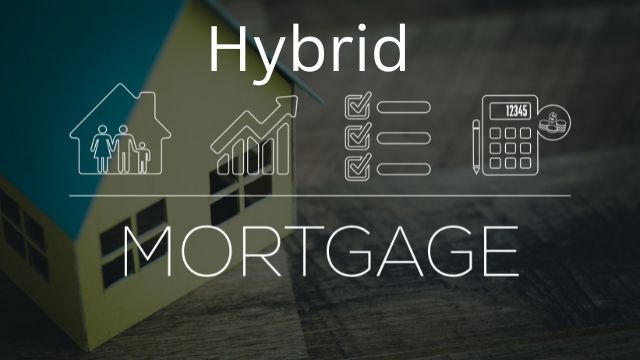The procedure of getting a mortgage is by no means universal. A hybrid mortgage provides a personalized method for compounding interest on your loan. A hybrid mortgage gives people who would prefer not to take on the risks involved in collecting interest within a single rate structure the best of the two options by providing access to both fixed and variable rates. However, before taking out a loan, it is advisable to consider all your options.
Meaning of a Hybrid Mortgage
A hybrid mortgage has features from both variable-rate and fixed-rate mortgages. It is often referred to as a combination or step mortgage. A hybrid mortgage is a form of adjustable-rate mortgage (ARM) with a fixed rate for a predefined amount of time and an adjustable rate for the remaining portion of the loan term.

Typically, borrowers are granted a fixed interest rate for ten years. After that, the interest rate can be changed like an ARM. The interest rate may change every month, every three months, every year, or every few years during the ARM.
Mortgage adjustments are calculated using an index. Lenders also add a margin percentage to the index to determine your mortgage interest rate. An index serves as a benchmark and point of reference, much like the LIBOR. And the state of the economy affects index rates. Rates may trend higher during prosperous economic times to stave off inflation. However, index rates may drop to boost the market amid an economic downturn.
A hybrid interest rate is an amalgamation of interest rates calculated at a fixed interest rate for a predetermined time. After that time, the borrower will switch to a variable interest rate, as stated in the loan agreement, for the remaining portion of the loan’s tenure.
The “5/1” hybrid mortgage is a common variant. This indicates that the variable portion of the mortgage is subject to renewal after a year, whilst the fixed portion continues for five years. Nonetheless, most mortgage experts advise matching the terms (e.g., five-year durations for each) so that both segments mature simultaneously. If you are dissatisfied with the renewal rate you are given, this makes switching lenders considerably simpler.
| Pros | Cons | Explanation |
|---|---|---|
| Lower initial interest rates | Rate uncertainty after the fixed period | Hybrid mortgages often start with a lower interest rate than fixed-rate mortgages, making initial payments lower. |
| Potential for lower payments | Potential for higher payments later | If interest rates drop or stay the same, payments can remain low; if rates rise, payments can increase significantly. |
| Flexibility in planning | Complex terms | They offer fixed rates for an initial period (e.g., 5, 7, or 10 years) followed by adjustable rates, providing some initial payment stability. |
| Benefit from falling rates | Payment shock risk | After the fixed-rate period, if interest rates fall, your payments could decrease; however, if they rise, you could face a significant increase in payments. |
| Easier qualification | Refinancing costs | Lower initial rates might make it easier to qualify for a larger loan amount compared to fixed-rate mortgages. |
| Short-term savings | Long-term uncertainty | You save money on interest during the initial period, but future rate adjustments can lead to unpredictability in payment amounts. |
| Suitable for short-term stays | Potential prepayment penalties | If you plan to sell the property before the adjustable period starts, you can take advantage of the lower rates without facing adjustment risks. |
| Possible rate caps | Rate cap limits | Rate caps can limit how much the interest rate can increase at each adjustment and over the life of the loan, but these caps might still allow significant increases. |
How does a Hybrid Mortgage Work?
The following formats are frequently seen while looking for a hybrid mortgage: 3/1, 5/1, or 10/1. The length of the mortgage rate’s fixed period is indicated by the first number, while the second number indicates the frequency of rate adjustments.
Initial teaser rate
Because the initial fixed teaser rate on a hybrid mortgage is usually less than the interest rate for a fixed-rate mortgage, this is its principal advantage. In the initial years of the hybrid ARM loan, this lower rate typically translates into a smaller monthly payment, making the loan more accessible. When the rate is flexible, though, it can go up or down, which would impact your monthly payment.
Margin and index
Two important variables are used to calculate interest rates for hybrid mortgages: index and margin. The percentage point the lender adds to the index to calculate the interest rate is known as a margin. Certain lenders might decide how much margin to apply to the index based on your credit history and score.
Lenders base their hybrid ARM loan interest rates on an index, which serves as a benchmark variable rate. The London Interbank Offered Rate (LIBOR), the Cost of Funds Index (COFI), and one-year constant-maturity Treasury (CMT) securities are the three major indices used for this purpose. It is crucial to remember that these indices frequently fluctuate in response to the state of the economy while comparing mortgage quotations. The rate quotes that you receive today can very well change tomorrow.
Interest rate and payment caps
Lenders can change the interest rate on your hybrid mortgage, which may impact your monthly payment, but their ability is limited.
The Consumer Financial Protection Bureau states that three different types of caps impact rate modifications:
Cap on initial adjustment: This is the maximum rate change your lender is permitted to make following the expiration of your fixed rate. The initial rate could be increased by two or five percentage points, depending on the cap, which is often set at either 2% or 5%.
Subsequent adjustment cap: All adjustments made after the first-rate adjustment are included in this cap. The rate typically can rise to 2%, or 2 percentage points, above the rate before.
Lifetime adjustment cap: The entire rate rise during the hybrid mortgage is called the lifetime adjustment cap. Your interest rate cannot rise over 5 percentage points above the original interest rate or the fixed rate you began with on the loan. This is because a typical lifetime adjustment cap is set at 5%.
These are standard rate caps, of course, although lenders are free to set their restrictions, so before you sign on the dotted line, be sure you understand what those restrictions are. Additionally, you want to examine rate caps offered by various lenders to observe how they alter within the loan term. Some lenders may have lower rate caps than others.
Eligibility
- $9 million or less in loans
- Manufactured housing communities and stable multifamily properties currently in existence that are available for purchase or refinancing
Pros of a hybrid mortgage
The long, fixed-rate period – a hybrid mortgage with a set initial interest rate that is good for a considerable length of time.
- Benefit of both types- You can benefit from both mortgages by having an ARM and a fixed-rate mortgage.
- Potentially lower beginning payments: Another advantage of a hybrid mortgage is that, compared to conventional fixed-rate mortgage products, it may have a reduced starting interest rate at the outset.
- Lower Mortgage: Since a lower interest rate may entitle you to a lower mortgage payment, you can save money upfront. The money you save during the transition phase can be applied to other areas of the new house, such as décor, upgrades, or furnishings. Savings over the long term may also result from a declining rate trend.
- Rate caps – Even when rates rise beyond the predetermined time frame, they cannot rise arbitrarily. There are minimal limits on how much your rate can fluctuate because hybrid mortgages have rate limitations.
Cons of a hybrid mortgage
The danger and unpredictability of paying more after the defined time, even with rate limitations. That way, in five, ten, or fifteen years, you will not know what your payments will be. To understand your rate, you must be informed of economic trends. However, you are still unable to forecast your interest rate in the future. A payment cap may induce negative amortization to generate a catastrophic financial loss.
Finally, Is a Hybrid Mortgage Worth It?
Before entering a hybrid mortgage arrangement, you should be informed of the state of the economy. You can refinance into a fixed-rate mortgage later with a hybrid mortgage. The value of your house or your credit score determines whether you are authorized or not.

Meet Suhas Harshe, a financial advisor committed to assisting people and businesses in confidently understanding and managing the complexities of the financial world. Suhas has shared his knowledge on various topics like business, investment strategies, optimizing taxes, and promoting financial well-being through articles in InvestmentDose.com


